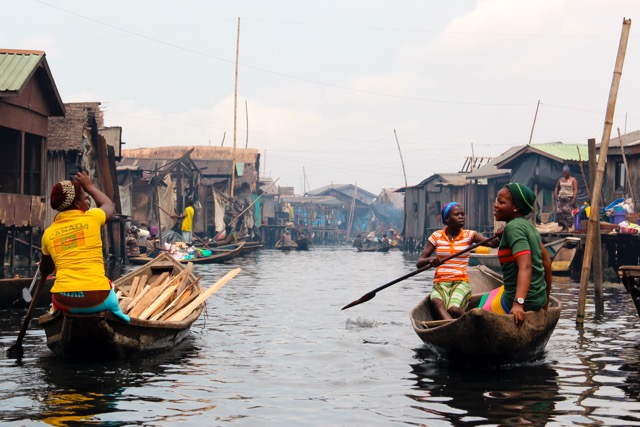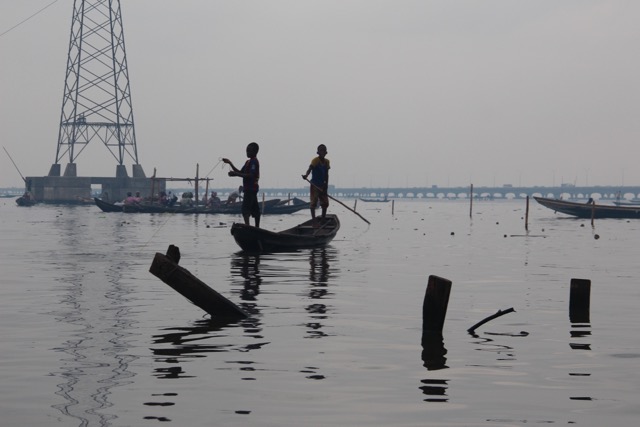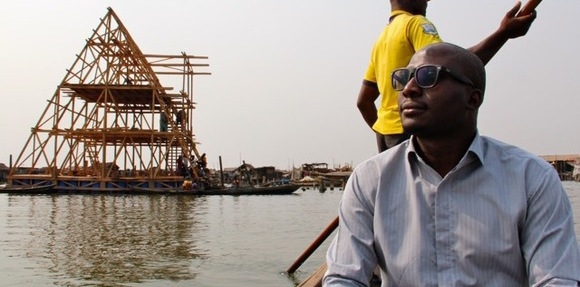The wooden structure put Makoko, the Lagos shanty town on water, on the map, got world wide attention from the media, and made its architect famous. But after the Floating School collapsed, many questions remained unanswered. Was the building project on the Lagos Lagoon really the success it claimed to be?
The triangular floating structure was a beacon on the Lagos Lagoon. It was clearly visible from the Third Mainland Bridge, 500 metres farther down, which made it impossible for Lagosian commuters whizzing by to ignore the rickety cabins of the Makoko slum behind the construction on the water. Completed in early 2013, within three years of its conception, the Floating School by Nigerian architect Kunlé Adeyemi had become a landmark. Not only in Lagos, but worldwide: journalists from all over the world wrote about the Floating School. CNN did a report; Adeyemi’s design made it into the Japan Architect World Yearbook; and in May this year the design won him and his Netherlands-based architecture firm NLÉ the Silver Lion at the Biënnale in Venice. He even sailed a replica of the school through the canals into the Italian city. Not even a week after that triumph, however, the original Floating School in Makoko collapsed after heavy rainfall.
Too dangerous
Let’s not beat around the bush: the famous Makoko Floating School was in use as such for no longer than four months of its existence. Only at the end of last year, two and a half years after its completion, did the first students attend classes in the school floating on blue barrels. But by early March they were pulled out again because the school’s headmaster considered the situation too dangerous.
Ten-year-old Elizabeth Awhawezun was one of those students. She didn’t mind abandoning the floating structure: ‘When it was windy, everything started shaking. That scared me.’ Her classmate Francis Kpengan, who is three years older, was not sorry to move out of there either: ‘When it rained our notebooks would get wet and we had to go downstairs for cover.’
The Floating School was meant as an extension to the Whanyinna School, a primary school on the lagoon that the Lagos Yacht Club had had erected as a charity project a couple of years before, but which was bursting at the seams with pupils. Why then was the floating extension not used for such a long time?
Headmaster Noah Shemede, who in 2013 still hailed architect Adeyemi for the opportunities he brought to Makoko for education, now claims: ‘From the beginning parents thought the construction was unsafe. They didn’t want their children in it.’ But Shemede eventually moved his pupils into the floating building because, he says, ‘Visiting journalists kept asking me why there were no classes being taught.’
According to insiders however, that is only part of the story. With the completion of the school, Shemede had also expected desks, chairs, books and other school material to be delivered. When that failed to happen, his enthusiasm for the project faded away.
Though the building was hardly utilised as a school, the local community used it extensively as a hangout for fishermen and other men from Makoko, and as a meeting place for local chiefs. Women did not frequent the floating community center, says fishmonger Janet Hungbo. ‘I sometimes tied up my canoe there to sell fish. Otherwise, as a woman, you had nothing to do there.’
Climate change
The school was not the aspect that most interested the financiers of the project. Monika Umunna of the Boell Foundation that paid for the preliminary study: ‘We were looking for climate resilient building for low income groups, for other ways to build on water, and a floating structure was a good idea.’ It also gave the Boell Foundation a means to show the Lagos State government that you can upgrade a slum area without evicting its dwellers.
That message got lost in the wave of publicity, she remembers: ‘Journalists were not interested in our master plan for Makoko, drawn up with the community. All they talked about was the Floating School.’ If only it had never been labelled a school, the Boell Foundation program manager sighs: ‘Kunlé is an architect, not a project manager. You can’t expect him to run a school.’

The actual building of the Floating School was subsidised by the UNDP, through the Africa Adaption Programme funded by the Japanese government. The UN organisation donated about $100,000 to the Floating School project, according to Muyiwa Odele of the UNDP in the Nigerian capital Abuja. ‘We were looking for innovations at a community level adapting to climate change. We were really excited about Adeyemi’s proposal because it was an all-inclusive thing: apart from bringing education to the children in Makoko, it would boost the local economy by generating employment and tourism.’
The UNDP employee was not aware that the structure was hardly used as a school: ‘From Abuja that is hard to check. We never went back to see the school in session.’ He remains positive about the project: ‘As a physical structure the school might have been a failure, but as an innovation it still stands.’
The request for a school extension came from the community itself, remembers Nigerian architect Isi Etomi. Makoko was the subject of her thesis, and she was working in the slum in 2011 when an American celebrity who had visited the shantytown on water expressed an interest to invest in a local charity project. Headmaster Shemede wished for an extension of his school and came to Etomi for advice on how to go about it. She involved Kunlé Adeyemi in the project as a designer, but when his firm came up with a proposal in which three quarters of the budget was taken up by consultancy fees, including business-class tickets for the architect, the American star pulled out. Meanwhile Adeyemi had found the UNDP and the Boell Foundation interested in funding the project.
Etomi and Adeyemi also parted ways at this point. ‘We were going in different directions. He was making a name for himself and his practice with the project. I think the best approach for a vulnerable community like Makoko is softly-softly. Not with grandiose projects that put the community at risk if anything goes wrong.’
Construction
Apart from the school aspect, what is the worth of the floating construction as an innovation? After all, it did collapse three years after completion. Dutch architect Robert van Kats was involved in the project in the conceptual phase, and provided the experts that made an estimate of the design. He still believes in the original design, but criticises the execution. The experts were involved in the project as volunteers and were not able to spend time to make a detailed design, and according to van Kats the building started from only that general consultation: ‘That is trial-and-error construction, in which you are taking a giant risk.’
Also, according to the Dutch architect, the advice about the mooring of the school was ignored. Already at the inauguration ceremony on the 2nd of March 2013 the Dutch floating expert van Kats had involved in the conceptual phase predicted that the anchors would not be able to hold the structure in place. In fact, in the following years the Floating School would break free of its anchors several times.
Perhaps the execution phase was cut back on? We would have liked to put this question to Kunlé Adeyemi himself, and had repeatedly requested an interview with him and his firm NLÉ, but were never granted the opportunity.
A fervid defender of Adeyemi’s and his Floating School is Ghanaian architect Joe Osae-Addo, president of the pan-African designer community ArchiAfrika. He is livid about the negative publicity since the structure fell apart. According to him, the project has inspired students of architecture all over the world: ‘A locally-trained Nigerian architect who took it upon himself to look at the existing condition of his people and make it better, isn’t that an amazing thing? Of course it is an experiment. The collapse however is an old story, because they have already built a better version in Venice that is waiting to return to Nigeria.’
After the collapse, the people of Makoko deconstructed the Floating School plank by plank, re-using the wood as building material. The blue containers that kept the structure above water are now floating in the front yard of the palace of baale Emmanuel Shemede, one of Makoko’s traditional leaders and the headmaster’s older brother. The people of Makoko have always had their doubts about the sturdiness of the construction, he says. The school’s ruin only confirmed their suspicions. ‘We know best how to build for this climate.’

So he would be against the building of another structure like that in his area? Shemede smiles, but says nothing. Why would he object, his smile seems to be saying.
The baale, one of the many in Makoko, together with his brother, was the main contact in the community for the architect. Every visitor to the Floating School also paid a courtesy call to this traditional leader, and many of them also left behind a monetary token of appreciation. Who would object to such a source of income?
In spite of everything, the residents of Makoko had been proud of the triangular floating structure, which people from all around the globe came to see. That much is clear: the Floating School brought Makoko international attention, and because of this the slum might be a less likely victim to the authorities always looking for prime real estate to sell off to developers.
The Dutch version of this article was published in OneWorld magazine.


